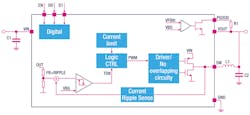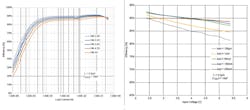Buck Regulator Has Minuscule Quiescent Current, On-the-Fly Adjustable Output
As the Internet of Things (IoT) and other applications increasingly embody functions with ultra-low duty cycles (think temperature sensing) while operating from severely limited energy sources (harvesting or 10-year batteries), low quiescent current is becoming a specification as important as actual operating current.
The ST1PS01 step-down (buck) dc-dc converter developed by STMicroelectronics (Fig. 1) features requisite small size and high efficiency, of course. It’s noteworthy for two other features: a quiescent-current value of 500 nA (typical), and its output voltage can be dynamically set to one of four values between 1.8 and 3.3 V via two digital-control inputs (the specific available four values depend on which ST1PS01 variant is ordered).
1. The STMicroelectronics ST1PS01 delivers up to 400 mA from a 1.14- × 1.41-mm flip-chip package, with quiescent current of just 500 nA and four digitally selectable output voltages that can be switched dynamically.
Key applications include asset tracking, gas/water energy meters, and long-term portable medical monitoring, to cite a few among many others. The IC, complete with integrated power switch, synchronous rectifier, and integrated compensation network, has an input-voltage range between 1.8 and 5.5 V (the 1.8-V minimum supply-input voltage allows use of various battery chemistries including a single lithium-based cell). Maximum delivered output current is 400 mA.
Typical efficiency is 94% at 1 mA load with VIN at 3.6 V and VOUT at 3.3 V (Fig. 2), while output voltage accuracy measures ±2%. When in use, the IC requires just a small inductor, two same-value capacitors, and a resistor (typically 2.2 µH, 10 µF, and 1 MΩ, respectively).
2. Performance of the ST1PS01 is characterized by multiple graphs showing efficiency vs. load for VOUT = 1.8 V (left) and efficiency vs VIN, for VOUT = 1.8 V (right).
Other features include undervoltage lockout (at 1.57 V), embedded soft-start circuit, overcurrent protection, active output-voltage discharge, and an output-voltage power-good flag. Small size is also a feature thanks to its 1.14- × 1.41-mm flip-chip package with 400-μm pitch. Design-in support is provided by the STEVAL-1PS01EJR evaluation board. Available now, the ST1PS01, specified for ambient temperature operation from −40 to +85°C, is priced at $0.686 each (1000-piece lots).
About the Author

Bill Schweber
Contributing Editor
Bill Schweber is an electronics engineer who has written three textbooks on electronic communications systems, as well as hundreds of technical articles, opinion columns, and product features. In past roles, he worked as a technical website manager for multiple topic-specific sites for EE Times, as well as both the Executive Editor and Analog Editor at EDN.
At Analog Devices Inc., Bill was in marketing communications (public relations). As a result, he has been on both sides of the technical PR function, presenting company products, stories, and messages to the media and also as the recipient of these.
Prior to the MarCom role at Analog, Bill was associate editor of their respected technical journal and worked in their product marketing and applications engineering groups. Before those roles, he was at Instron Corp., doing hands-on analog- and power-circuit design and systems integration for materials-testing machine controls.
Bill has an MSEE (Univ. of Mass) and BSEE (Columbia Univ.), is a Registered Professional Engineer, and holds an Advanced Class amateur radio license. He has also planned, written, and presented online courses on a variety of engineering topics, including MOSFET basics, ADC selection, and driving LEDs.



